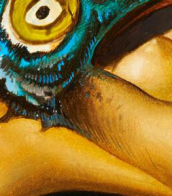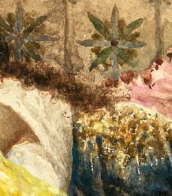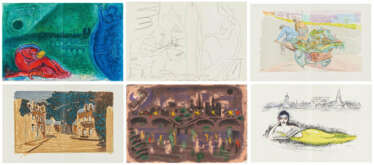sebastian gögel

Sebastian Gögel is a German painter and sculptor living and working in Leipzig.
Gögel graduated from the University of Graphic and Book Arts in Leipzig and has been working with Paul Hammer (1975) in the HAGEL project since 2005. Extremely diverse in his work, working methods, themes and concerns, Gögel fits into a unique tradition of German erudite conceptual artists. Through exaggerations, caricatures, and grotesques, Gögel simultaneously utilizes and refutes morality and representationalism. The artist's surrealistic paintings and highly varied styles are appealing and horrifying at the same time.


Sebastian Gögel is a German painter and sculptor living and working in Leipzig.
Gögel graduated from the University of Graphic and Book Arts in Leipzig and has been working with Paul Hammer (1975) in the HAGEL project since 2005. Extremely diverse in his work, working methods, themes and concerns, Gögel fits into a unique tradition of German erudite conceptual artists. Through exaggerations, caricatures, and grotesques, Gögel simultaneously utilizes and refutes morality and representationalism. The artist's surrealistic paintings and highly varied styles are appealing and horrifying at the same time.


Sebastian Gögel is a German painter and sculptor living and working in Leipzig.
Gögel graduated from the University of Graphic and Book Arts in Leipzig and has been working with Paul Hammer (1975) in the HAGEL project since 2005. Extremely diverse in his work, working methods, themes and concerns, Gögel fits into a unique tradition of German erudite conceptual artists. Through exaggerations, caricatures, and grotesques, Gögel simultaneously utilizes and refutes morality and representationalism. The artist's surrealistic paintings and highly varied styles are appealing and horrifying at the same time.


Johann Georg Bergmüller was a German painter, particularly of frescoes, of the Baroque.



Maître François was a French illustrator who worked in Paris in the 1460s-1480s.
The identity of Maître François as an artist is first mentioned in a letter written by Robert Gauguin in 1473. Most of the prestigious commissions from the court and leading ecclesiastical figures of the time were carried out in François' studio. In Paris in the second half of the fifteenth century, one can trace the predominant style of illumination by the works of Master Jean Rolin, Maître François, and Master Jacques de Besançon. Bibliophiles close to the royal court encouraged the work of miniaturists through private commissions. In particular, Jacques d'Armagnac owned six manuscripts of Maitre Francois and his entourage.
Boccaccio's De casibus virorum illustrium was very popular in the 15th century, where the author retells the fates and downfalls of famous personalities from the Bible, antiquity and medieval history, ending with Boccaccio's own contemporaries in 14th-century Florence. For a long time this book was even more famous and successful than Boccaccio's Decameron. The text was translated into French in 1409 for Jean, Duke de Berry, by his secretary Laurent Premieffe. And the illustrations for the book were later created in the workshop of the then respected Maître François.




















































































